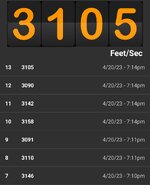300WSM
Handloader
- Dec 24, 2011
- 838
- 470
How much will differing case mfg impact velocity?
I did this test with three different case mfg's...
All trimmed to same length!
Bullet seated same depth!
Same powder and exact charge!
Same #41 primer
Shot in random order to further magnify the variances...
As if someone just grabbed miscellaneous brass and loaded up and hunted and or shooting a group...
Significant or insignificant?
Only you the shooter could answer that but I can say 100 fps as a rule of thumb will differ approximately 1"-1.5" for a 30 cal with a 180 gr bullet at 500 yards all things being equal
Where as a 22 cal with a simple 55gr FMJ/BT will see a 2.5"-3" difference at 500 yards all things being equal.


I did this test with three different case mfg's...
All trimmed to same length!
Bullet seated same depth!
Same powder and exact charge!
Same #41 primer
Shot in random order to further magnify the variances...
As if someone just grabbed miscellaneous brass and loaded up and hunted and or shooting a group...
Significant or insignificant?
Only you the shooter could answer that but I can say 100 fps as a rule of thumb will differ approximately 1"-1.5" for a 30 cal with a 180 gr bullet at 500 yards all things being equal
Where as a 22 cal with a simple 55gr FMJ/BT will see a 2.5"-3" difference at 500 yards all things being equal.






